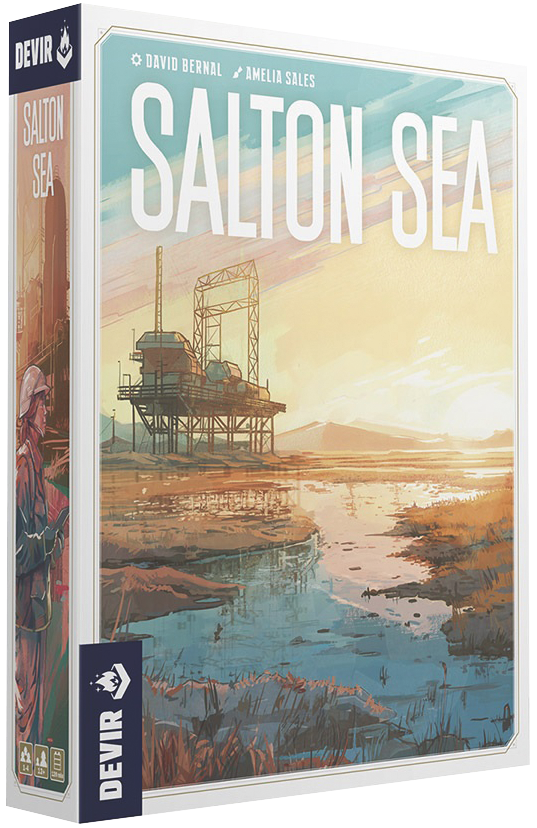18 October 2024
|
It may not have the most exciting of themes, but Salton Sea is a fun worker placement board game that we'd recommend finding your sea legs with. Who says boardgames can’t teach complex environmental and industrial processes? Not Devir!
Written by Chris Jarvis
Who fancies playing a board game about drilling saline groundwater and turning it into power and batteries? Yay? I’ll be honest: in a hobby which covers some pretty niche/dull topics as a background, even I found myself blushing a little when I tried explaining this one. Salton Sea is about the real-life process of drilling geothermal areas in Southern California and turning that into sustainable geothermal power and lithium for batteries. Honestly, I found myself quite fascinated! For the really curious there is a whole double-page article in the front of the manual all about the setting and science of the game, so there is definitely passion behind this project.

Playing Salton Sea
This is a worker-placement game with a very tight economy. Each player has their own board, so there is no competition for spaces, but efficiencies and timing are the key to victory. It’s the kind of game where you spend $5 worth of resources to gain $8 back. It’s a very slow burn and every additional saving or advantage contributes to your result.
In terms of rules complexity, it’s not an overly complex example of the genre. Actions are intuitive, and the means by which brine is extracted, then turned into resources, and then either sold or used to fulfil public contracts is made very clear. You will need to balance purchasing additional drilling rights, upgrading your storage facilities, gaining research powers and even buying shares in each of the three main consumers of your product.
By far the most interesting aspect of Salton Sea is the money. Each money card contains a worker-placement space which is an upgraded form of one of your basic spaces. For example: instead of taking the usual single drilling action, one of the $1 cards features a double drill worker space; while the $5 variant negates potential drill-head damage. Upgraded cards also include cheaper rates for converting brine to energy, and financial discounts on repairs and research.
The challenge is that while you need to spend money to make money, in this instance spending that money results in losing an ability. Placing a worker on a card also makes that money unavailable until the next round. There are only seven variants of each card so they cycle back but there are no guarantees, especially with the interference of other players. It’s a balance which only gets more interesting as the game progresses; the higher denominations of cards in use raise abilities but losses. I’ve found myself making less advantageous sales, purely in order to gain a money card’s upgrade while I can.
Salton Sea Review
If I had one complaint, it is about the card display. At the end of each round, the right-most card is discarded, the discard pile is placed under the deck and new cards are drawn to refill the display. There are five rows of cards, and in the early part of the game you only take four actions per round. I found the feeling of constantly discarding and refilling so many rows quickly became a chore, especially in the solo game (which is otherwise very enjoyable).
The environmental theme of Salton Sea runs throughout its production. All of the components are primarily paper, cardboard and wood and the decks of cards are bound using paper bands. This can make putting the cards away a bit of a dexterity challenge, but it’s certainly doable.

For me, the visual design is a little at-odds with the theme. Perhaps in keeping with the environmental message of the production, the art is presented in muted pastels and minimalist aesthetic. Given that this is a simulation of heavy industry, these components would feel more at home in a game about painting watercolour landscapes.
Overall, Salton Sea is a very solid and interesting economic game. The random elements of setup probably don’t cause a huge change-up each game (due to the incremental nature of progress) but there’s certainly enough variance to prevent each game being identical. The tight margins and efficiency of play required will certainly appeal to fans of complex business games; and, the conflict between holding money cards for their abilities versus spending money to progress remains a fascinating puzzle.
Should you play Salton Sea? Yes, if you like games with flexible ability upgrades and enjoy a slow burn to victory through careful planning. You should also try this if you liked Manhattan Project's approach to upgrading your board, gaining additional workers and victory through efficient resource usage.
Related article: Looking for less diving and more origami with your sea? Try Sea Salt and Paper.
The Box
Designer: David Bernal
Publisher: Devir
Players: 1-4
Ages: 12+
Time: 2h
Price: £33
- Game Board
- 4 Company Boards
- 4 Starting Claim Tiles
- 4 Cheat sheets
- 12 Warehouse tiles
- 16 Claim cards
- 28 Research cards
- 114 Action cards
- 22 Contract cards
- 14 Objective cards
- 15 Wooden pieces
- 12 Exhausted claim tokens
- 25 Profit sharing tiles
- 12 Fee tiles
- 9 Cards for solitaire mode
Sometimes we may include links to online retailers, from which we might receive a commission if you make a purchase. Affiliate links do not influence editorial coverage and will only be used when covering relevant products







